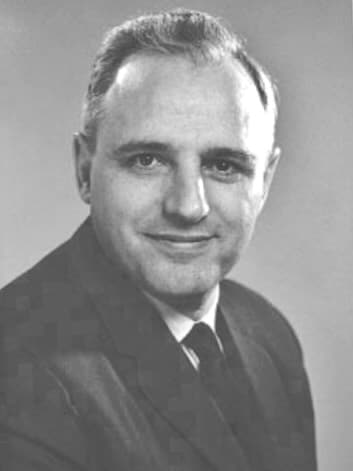Leslie Zieve

Leslie Zieve (1915-2000) was an American hepatologist
Zieve was an American internist and hepatologist whose research into alcohol-related liver injury and haemolytic anaemia defined Zieve syndrome as a distinct clinical entity. His careful observation of patients with transient jaundice, hyperlipidaemia, and haemolytic anaemia in the context of alcoholic hepatitis led to the recognition of a self-limited but diagnostically important syndrome that broadened understanding of hepatic–haematologic interactions in alcohol misuse.
Born in Minneapolis, Minnesota, Zieve trained and spent his career in the city, working with the Veterans Administration Hospital, the Hennepin County Medical Center and the University of Minnesota, where he served in the Department of Medicine and the Radioisotope Service. Zieve continued to research liver function, lipoprotein metabolism, and alcohol-related pathology throughout his career, publishing widely on hepatic biochemistry and clinical hepatology.
Biographical Timeline
- 1915 – Born August 6 in Minneapolis, Minnesota, USA, to Joseph and Hanna “Annie” Zieve.
- 1940s – Completed his medical training and internship in Philadelphia, then served as a battalion surgeon during World War II, where he had responsibility for battlefield casualties.
- Postwar (late 1940s–1950s) – Returned to Minneapolis and joined the Veterans Administration Hospital, where he developed a strong research program in hepatology, lipid metabolism, and haematology. He became Chief of the Radioisotope Service and later Associate Chief of Staff for Research, noted for fostering scientific collaboration and innovation.
- 1958 – Described a new hepatic syndrome characterised by jaundice, hyperlipidaemia, and haemolytic anaemia, later known as Zieve’s syndrome
- 1962 – The term “Zieve’s syndrome” first appeared in print following confirmation of similar cases at the State Veterans Hospital in Rocky Hill, Connecticut, solidifying the eponym.
- 1970s–1980s – Continued publishing on hepatic physiology, porphyria, and the biochemical basis of liver-related anemias.
- 1983 – Reflected on his discovery in Current Contents as a “citation classic,” noting his initial surprise at the syndrome’s later recognition.
- Career Honours – Recipient of the Middleton Award, the U.S. Veterans Administration’s highest scientific honour, and the Minnesota Chapter Laureate Award of the American College of Physicians.
- 2000 – Died May 9, aged 84, in Spring Park, Minnesota.
Medical Eponyms
Zieve Syndrome (1958)
Zieve syndrome is a distinct, acute metabolic condition associated with chronic alcohol use, defined by the triad of jaundice, hyperlipidaemia, and haemolytic anaemia. The syndrome typically occurs during or shortly after episodes of heavy drinking, often accompanied by abdominal pain and mild fever. The course is self-limiting, resolving within weeks following alcohol abstinence.
Zieve syndrome is pathophysiologically linked to alcohol-induced fatty liver and transient metabolic derangements, with haemolysis likely resulting from changes in red cell membrane lipids, lysolecithin-mediated haemolysis, and pyruvate kinase instability. These mechanisms, supported by later studies (e.g., Balcerzak et al., 1968; Melrose et al., 1990), explain the reversible nature of the anaemia and jaundice. No specific therapy exists beyond supportive management and alcohol cessation, which rapidly restores normal lipid metabolism and erythrocyte stability.
1958 – At the 38th Annual Meeting of the American College of Physicians in Boston, Leslie Zieve presented a series of 20 alcoholic men with jaundice, haemolytic anaemia, and hyperlipaemia seen over eight years at the Minneapolis Veterans Hospital.
Zieve noted that the haemolysis was mild and short-lived, with fatty infiltration and minimal cirrhosis on biopsy. The recognition of this constellation of findings helped to distinguish it from obstructive jaundice, sparing many patients from unnecessary surgical exploration.
Twenty patients have been observed who exhibited an interesting group of manifestations heretofore not recognized as a distinct syndrome with a predictable course. The essential clinical features are jaundice, hyperlipemia or hypercholesterolemia, and hemolytic anemia. The illness follows excessive drinking, and improves rapidly once the drinking stops, the hyperbilirubinemia and hypercholesterolemia receding over a few weeks. Hemolysis is generally slight and of short duration. The anemia is mild or moderate and does not persist. Hepatic function is usually mildly disturbed and improves rapidly. The anatomic abnormality on liver biopsy is fatty infiltration and minimal to moderate portal cirrhosis.
Zieve 1958
1962 — Kessel et al. first suggested the term Zieve’s syndrome. They published six additional cases, confirming Zieve’s triad and suggesting lysolecithin, a lipid metabolite from lecithin via pancreatic lipase, as a key haemolytic agent.
1990 – Melrose et al demonstrated that Zieve’s syndrome could occur independently of cirrhosis, sometimes recurring with relapses of alcohol use, and linked severe hypertriglyceridemia to complications such as intracranial haemorrhage and pancreatitis.
2000s–Present. Though uncommon (estimated 1 in 1,600 hospital admissions), the syndrome remains clinically relevant as a reversible cause of haemolysis and jaundice in alcoholics. Reviews emphasise avoiding misdiagnosis as biliary obstruction or hepatitis, and ensuring accurate decision-making in alcoholic hepatitis due to falsely elevated bilirubin levels.
Major Publications
- Zieve L. Jaundice, hyperlipemia and hemolytic anemia: a heretofore unrecognized syndrome associated with alcoholic fatty liver and cirrhosis. Ann Intern Med. 1958 Mar;48(3):471-96. [Zieve syndrome]
- Zieve L, Hill E. Hemolytic anemia in cirrhosis. South Med J. 1959 Aug;52(8):903-11.
- Zieve L. Hemolytic anemia in liver disease. Medicine (Baltimore). 1966 Nov;45(6):497-505.
- Zieve L, Doizaki WM, Zieve J. Synergism between mercaptans and ammonia or fatty acids in the production of coma: a possible role for mercaptans in the pathogenesis of hepatic coma. J Lab Clin Med. 1974 Jan;83(1):16-28.
- Zieve FJ, Zieve L, Doizaki WM, Gilsdorf RB. Synergism between ammonia and fatty acids in the production of coma: implications for hepatic coma. J Pharmacol Exp Ther. 1974 Oct;191(1):10-6
- Zieve L. The mechanism of hepatic coma. Hepatology. 1981 Jul-Aug;1(4):360-5.
- Zieve L. This week’s citation classic. Current Contents 1983; 38: 18. [Zieve syndrome]
- Zieve L, Doizaki WM, Lyftogt C. Brain methanethiol and ammonia concentrations in experimental hepatic coma and coma induced by injections of various combinations of these substances. J Lab Clin Med. 1984 Nov;104(5):655-64.
- Zieve L. Pathogenesis of hepatic encephalopathy. Metab Brain Dis. 1987 Sep;2(3):147-65.
References
Biography
- Reuben A. True, True…But Are They Related? Hepatology 2006; 43(3): 635-639
- Балуцкий ВB, Ковалев СB. Синдром Циве: история эпонима, описание случая. Лечащий Врач. 2025; 2(28): 27-31.
Eponymous terms
- Kessel L. Acute transient hyperlipemia due to hepatopancreatic damage in chronic alcoholics (Zieve’s syndrome). Am J Med. 1962 May;32:747-57.
- Balcerzak SP, Westerman MP, Heinle EW. Mechanism of anemia in Zieve’s syndrome. Am J Med Sci. 1968 May;255:277-87.
- Melrose WD, Bell PA, Jupe DM, Baikie MJ. Alcohol-associated haemolysis in Zieve’s syndrome: a clinical and laboratory study of five cases. Clin Lab Haematol. 1990;12(2):159-67.
- Hashmi S, Allison MG, McCurdy MT, Reed RM. Hyperbilirubinaemia and haemolytic anaemia in acute alcoholic hepatitis: there’s oil in them thar veins. BMJ Case Rep. 2014
- Shukla S, Sitrin M. Hemolysis in Acute Alcoholic Hepatitis: Zieve’s Syndrome. ACG Case Rep J. 2015 Jul 9;2(4):250-1.
- Achufusi TG, Sandhu J, Chahal J, Shepherd Z, Mirchia K. Zieve syndrome in acute alcoholic hepatitis. Proc (Bayl Univ Med Cent). 2020 Mar 13;33(3):380-381.
Eponym
the person behind the name
BM BCh, Oxford University. Currently training in Australia. Career interest in Hepatology and Emergency Medicine
BA MA (Oxon) MBChB (Edin) FACEM FFSEM. Emergency physician, Sir Charles Gairdner Hospital. Passion for rugby; medical history; medical education; and asynchronous learning #FOAMed evangelist. Co-founder and CTO of Life in the Fast lane | On Call: Principles and Protocol 4e| Eponyms | Books |

